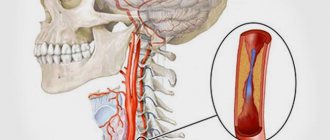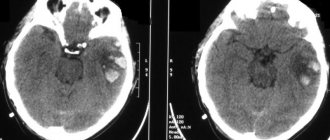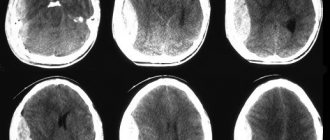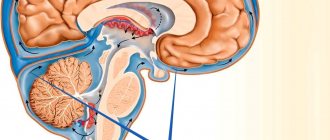Disorders of the venous circulation of the brain
Classification. The following chronic and acute variants of venous circulation in the brain are distinguished. Chronic include venous congestion and venous encephalopathy, acute include venous hemorrhage, thrombosis of the veins and venous sinuses, thrombophlebitis.
Venous stagnation. The most common form of venous circulation disorder is due to various reasons: cardiac and cardiopulmonary failure, respiratory diseases (bronchitis, bronchiectasis, bronchial asthma, emphysema, etc.); compression of extracranial veins (internal jugular, innominate, superior vena cava), struma, arterial aneurysm, tumor in the neck; neoplasms of the brain, membranes and skull, arachnoiditis, traumatic brain injury, thrombosis of the veins and sinuses of the dura mater, compression of the veins with cerebral edema and craniostenosis. With venous stagnation, metabolic changes and brain hypoxia occur, venous and intracranial pressure increases, and cerebral edema develops. More often, milder disorders occur in the form of changes in the tone of the cerebral veins, which is detected using orbital plethysmography and rheography.
Clinical manifestations. A dull headache, more pronounced in the morning, increases with movements of the head to the sides, changes in atmospheric pressure, changes in ambient temperature, after excitement, drinking alcohol, etc., there is a hum or noise in the head, cyanotic lips, cheeks, ears, nose , mucous membranes of the oral cavity, swelling of the lower eyelids, especially in the morning, dilation of the veins in the fundus. Venous pressure ranges from 55 to 80 mmH2O, arterial pressure is usually within normal limits. Stupefaction, dizziness, darkening of the eyes, fainting, and numbness of the extremities are observed. Epileptic seizures and mental disorders are possible. With severe venous stagnation, patients are unable to lower their heads and remain in a horizontal position.
Measurements of pressure in the ulnar vein, radiography of the skull (increased development of diploic veins, graduates and veins of the dura mater), and phlebography are of diagnostic value in venous pathology.
Venous encephalopathy. With venous encephalopathy, the following syndromes are distinguished: hypertensive (pseudotumorous), diffuse small-focal brain damage, bettolepsy and asthenic.
Bettolepsy, or cough epilepsy, develops with chronic bronchitis and emphysema, pneumosclerosis, bronchial asthma, especially with cardiopulmonary failure. A persistent cough may result in sudden loss of consciousness (syncope).
Venous hemorrhages. Capillary-venous hemorrhages in the brain and capillary-venous stasis are observed in hypertension. Venous stroke occurs in patients with heart failure, traumatic brain injury, brain tumor, infectious and toxic brain lesions. Clinical manifestations develop slowly: confusion, speech disorders, diplopia, pyramidal reflexes, hemiparesis, hemihypesthesia, damage to cranial nerves.
Thrombosis of cerebral veins. It occurs in the practice of clinicians of many specialties as a complication of various inflammatory processes, infectious diseases, operations, abortions, pregnancy, childbirth, skull trauma, “blue” heart defects, etc. Changes in the walls of the veins, a slowdown in the speed of blood flow and increased blood clotting play a role in the pathogenesis, as well as a change in the colloidal properties of endothelial cells, which contributes to the aggregation of blood cells. Often, thrombosis of the cerebral veins is combined with thrombosis of the sinuses of the brain, as well as the veins of the lower extremities.
Clinical manifestations. Cerebral vein thrombosis usually develops gradually. Headache, nausea, vomiting, meningeal symptoms, congestive optic discs, increased body temperature, and increased ESR appear. In the cerebrospinal fluid, mild pleocytosis and an increase in protein content, sometimes blood, are detected. Characterized by confusion, partial motor-type seizures, and less commonly generalized convulsions. Depending on the location of the venous lesion, focal symptoms occur: aphasia, alexia, hemianopsia, flaccid or spastic paresis or paralysis, and sensory disturbances. The outcome is often favorable, focal symptoms often undergo significant or even complete regression, but there are relapses of the disease. A slow chronic course over many months and even years is possible. Sometimes there are consequences in the form of mental disorders, aphasia, convulsive seizures and paresis of the limbs.
Thrombosis of the dural sinuses. Usually develops when infection penetrates into them from a nearby focus (furuncles or carbuncles of the scalp, face, erysipelas, etc., purulent osteomyelitis of the skull bones, purulent acute and chronic otitis media, mastoiditis, purulent processes in the orbit, paranasal sinuses) along the brain and diploic veins. In addition, phlebitis and thrombosis of the dural sinuses can occur hematogenously with thrombophlebitis of the veins of the extremities or pelvis and during septic processes. Thrombosis of the cerebral sinuses is sometimes accompanied by thrombophlebitis of the retinal veins, purulent meningitis, brain abscesses, etc. Sinus thrombosis can also occur with chronic infections (tuberculosis), malignant tumors and other diseases that occur with cachexia, in debilitated patients and in old age.
Clinical manifestations. Low-grade or sometimes very high, stable or fluctuating body temperature, headache, vomiting, leukocytosis in the blood, increased intracranial pressure. With thrombosis of the sinuses of the convexital surface of the brain, general cerebral symptoms predominate; in the sinuses of the base of the brain, signs of damage to the cranial nerves predominate. Drowsiness develops, sometimes, on the contrary, motor restlessness, insomnia, delirium, epileptic seizures, rigidity of the neck muscles, Kernig's symptom, hyperesthesia to visual, auditory and skin stimuli, and sometimes trismus. Focal symptoms of brain damage correspond to the location of the sinus. Swelling and cyanosis of the face or mastoid area are noted. In the fundus, dilated veins and swelling of the optic discs are detected. The cerebrospinal fluid is clear or xanthochromic, sometimes with an admixture of red blood cells; moderate pleocytosis is noted. Septic thrombosis of the dural sinuses is manifested by chills and very high remitting temperature. With thrombosis of the superior sagittal sinus, epileptic seizures of the motor type, hemi- and paraplegia or paresis occur.
Symptoms of thrombosis of the transverse or sigmoid sinus: headache, bradycardia, sometimes double vision, septic temperature, chills, stupor, turning into a soporous and even comatose state, sometimes delirium and agitation, anti-pain position of the head with an inclination to the painful side, meningeal phenomena, leukocytosis in blood. The jugular vein may be involved in the process. In this case, swelling of the tissue surrounding the vein and signs of damage to the glossopharyngeal, vagus, accessory and hypoglossal nerves occur.
Symptoms of cavernous sinus thrombosis: exophthalmos, swelling and venous hyperemia of the eyelids, orbits, forehead, root of the nose, dilation of the fundus veins (congestion), pain and hyperesthesia in the area of innervation of the superior branch of the trigeminal nerve, chemosis of the conjunctiva, ophthalmoplegia - paralysis or paresis of muscles, innervated by the III, IV, VI cranial nerves, stupor, delirium, sometimes coma, metabolic and endocrine dysfunction.
Complications: purulent meningitis, metastatic abscesses in the lungs, septic pneumonia.
Thrombophlebitis of the cerebral veins. With thrombophlebitis of the cerebral veins, the temperature rises to subfebrile levels with periodic rises to 38–39 °C. Patients complain of headache, nausea, and vomiting. Observed stupor, stuporous state, epileptic seizures, paresis of the limbs; in the fundus – swelling and dilation of veins; in the blood - leukocytosis; in the cerebrospinal fluid - slight pleocytosis, an increase in the amount of protein and positive protein reactions, sometimes an admixture of erythrocytes.
Stages and forms of the disease
The mechanism of development of venous stagnation in the head regions has not been sufficiently studied. It is believed that obstructed venous outflow, which affects the vascular system of the brain, occurs due to a violation of the nervous regulation of blood flow. As a consequence of pathological processes, the venous walls lose elasticity and flexibility. If the disorder is observed once, this does not contradict natural physiology. Growing into a chronic form, the pathology acquires a health-threatening character.
There are varieties of the disease, which is manifested by difficulty, deterioration of venous outflow from the structures of the brain - primary and congestive (secondary) forms. The primary form develops due to a decrease in the tone of the venous wall. Most often associated with traumatic brain injuries, hyperinsolation, cerebral atherosclerosis, acute intoxication, including chronic alcohol and drug abuse, heart and vascular diseases. The pathogenesis is based on a violation of the nervous regulation of venous tone.
The stagnant form occurs due to a deterioration in the process of blood drainage from the internal cranial space. The main causes of the congestive (secondary) form are lung diseases that occur in a chronic form (bronchiectasis, pneumosclerosis), mechanical factors (compression of extracranial and intracranial veins as a result of tumor growth, traumatic brain injuries accompanied by deformation of the venous tracts). In the primary form, the symptoms are milder and less pronounced. The stages of development of pathology are distinguished:
- Latent.
- Cerebral venous.
- Venous encephalopathy.
Venous latent discirculation occurring in the brain area is a disease that occurs without severe symptoms, which makes early diagnosis difficult. The cerebral venous stage is accompanied by pain in the head and neck, but does not manifest itself as neurological disorders.
Encephalopathy, formed against the background of venous stagnation, is a condition that significantly worsens the quality of life and poses a serious threat to health. The third stage of the pathology is characterized by motor dysfunction, deterioration of vision and hearing, and epileptic seizures.
Symptoms and manifestations of pathology
Symptoms of disruptions in the process of venous outflow and thrombosis of the venous system are in many ways similar to the general manifestations of circulatory disorders in the structures of the brain. Signs of pathology intensify if a person takes a horizontal position, when making sudden movements or repeated turns of the head, or physical activity. What to pay attention to:
- Headache, worse in the morning, accompanied by dizziness and glare before the eyes.
- Swelling of the optic disc – the end of the optic nerve.
- Transient numbness of the limbs.
- Swelling in the lower eyelid area.
- Neurological disorders (at the third stage of development) - impaired motor skills and sensitivity, confusion, deterioration of visual and auditory function, aphasia (complete or partial loss of speech function), loss of orientation in space.
Damage to the cerebral veins is accompanied by neurological syndromes with focal localization. If the patency of the venous sinuses is impaired, signs of increased intracranial pressure predominate. Epileptic seizures may occur. Signs of obstruction of blood flow in all basins are manifested by a variety of symptoms, which makes it difficult to differentiate the primary pathology.
Symptoms of venous stagnation in the veins and vessels of the brain are aggravated if the patient has bad habits (abuse of alcoholic beverages, smoking). Having discovered signs of malfunctions in the circulatory system and venous circulation, it is better to immediately make an appointment with a neurologist.
Causes
The cranial cavity contains elements of the vascular system, which include arteries and veins of different diameters. Arteries account for 10% of the vascular bed, capillaries occupy 5% of the circulatory system of the brain, veins – 85%. It is venous pathologies that significantly affect the process of blood circulation inside the head. Superficial veins lie in the pia mater. Through these transport pathways, physiological fluid is removed from the internal tissues of the head - white matter and cortical structures.
Venous blood moves from the brain along the jugular vein. The pathogenesis of the disorder, the deterioration of the venous outflow that occurs in children and adults, is associated with congestion in the pulmonary circulation and in the superior vena cava, which runs in the brain. Right ventricular failure is often observed simultaneously. In addition to hemodynamic factors, failures of neuro-reflex mechanisms play an important role in the development of pathology.
Mutation of the prothrombin gene, deficiency of coagulation proteins, hyperhomocysteinemia, antiphospholipid syndrome lead to the development of thrombophilia - a blood clotting disorder. The diagnosis of thrombophilia and other pathologies of the hemostatic system are among the factors that increase the risk of developing dyshemia. Other causes of outflow disturbance:
- Hereditary predisposition.
- Injuries received in the head area.
- Malfunctions of the endocrine system.
- Suffered a stroke.
- Abnormal development of elements of the vascular system - vascular malformation (improper connection of veins and arteries), dysplasia, collaterals (bypass paths of the blood flow system), aneurysms (pathological expansion of the vascular bed).
- Uncontrolled, long-term use of medications with a vasodilating effect.
- Infectious diseases occurring in acute form.
- Emergency conditions - myocardial infarction, hypertensive crisis, sunstroke, acute intoxication.
- Increased blood clotting.
Vascular and venous dysplasia is a congenital pathology that causes venous stagnation. Venous dysplasia, found in the venous system of the brain, causes obstruction of blood flow and blood stagnation, and if left untreated, leads to thrombosis and hemorrhagic strokes.
Aggravating factors such as poor nutrition, excess weight, chronic diseases of internal organs, arterial hypertension, pathologies of blood vessels (atherosclerotic changes) and spine (osteochondrosis), wearing tight clothes, tight ties have a negative impact on the condition of a patient with identified venous dysfunction occurring in the brain. . Disorders and disruptions in blood flow can occur due to chronic stress, physical and mental stress, and unfavorable working conditions.
Diagnostics
Timely diagnosis and correct therapy will help improve well-being if the venous outflow process is disrupted. When making a diagnosis, the patient’s medical history, complaints, features of symptoms and clinical course are taken into account. The doctor measures the blood pressure in the central vein that runs through the retina. To identify disorders, many methods are used to study the circulatory system located in the brain. Instrumental methods:
- Transcranial Dopplerography.
- Cerebral angiography.
- Duplex scanning of elements of the vascular system of the brain.
- Ophthalmoscopy.
- MR venography.
- MRI and CT.
CT allows one to differentiate dysgemia from diseases with similar symptoms (tumors of brain tissue, intracranial hematoma, abscess). Venous disorders are represented in photographs and in research results by blockage of the sinuses and veins running in the head cavity. Foci of venous hemorrhages and infarctions caused by blockage of venous blood flow may be observed.
The ultrasound method ECHOEG (echoencephalography) and rheographic diagnostics REG (rheoencephalography) are used to assess the cerebrospinal fluid and venous circulation in newborns and older children. An echo-encephalogram in a mild form of dysgemia in a child shows signs of hypertensive-hydrocephalic syndrome (increased intracranial pressure values), asymmetry of blood flow in the area of the cerebral arteries.









